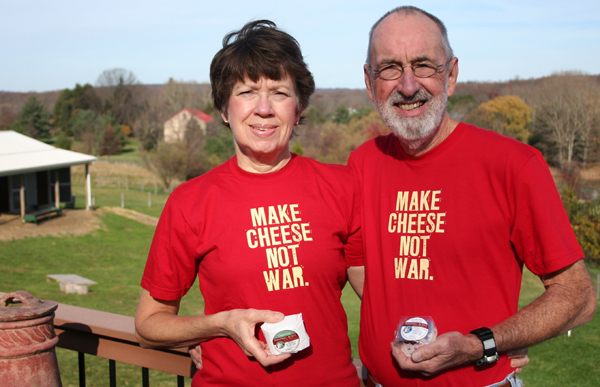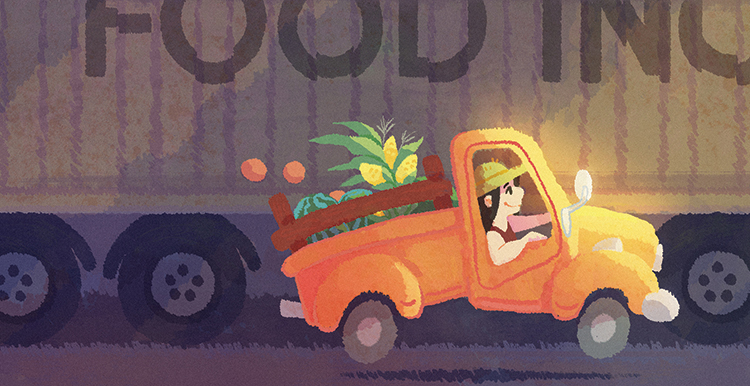 Amazing Acres Dairy produces local, artisanal chevre
Amazing Acres Dairy produces local, artisanal chevre
by Tenaya Darlington
Last May, Debbie Mikulak embarked on a lifelong dream—she became an artisanal goat cheese maker. With 19 goats and a little over five acres in Elverson, PA, she and her husband, Fred Bloom, now produce more than a dozen cheeses, including a French-style Banon wrapped in grape leaves and soaked in brandy.
Mikulak, 61, developed an affection for goats back in second grade when she raised them for her 4-H club in North Central New Jersey. Over the years, she has raised goats and sheep. (“We just had them as pets,” she explains.) It wasn’t until 2003, when she and Bloom bought the farm in Elverson, that she took the plunge into cheese-making. They built a milking barn and cheese room from the ground up, and, in 2007, Mikulak completed a certification program at the Vermont Institute of Artisan Cheese (VIAC), a two-week program offered by the University of Vermont.
To be considered “artisanal” in the cheese world requires a commitment to simplicity and purity. According to the American Cheese Society (ACS), artisanal cheese must be produced by hand, in small batches, with as little mechanization as possible. Mikulak makes cheese twice a week in the cheese room that she built under her ranch house, and each batch begins with a mere 20 to 25 gallons of fresh goat milk.
She extends the care she puts into hand-making her cheese into tending her animals. “We keep our goat babies with their moms,” she explains. “Goats are very intelligent, so we think that bonding is important.” She is also passionate about staying small. “We don’t want to over-pasture our land. Plus, this is a retirement business for us,” she laughs. “We’ve been wanting a goat dairy for 25 years.”
To start, Mikulak made chevre—fresh unaged goat cheese. “People told me that was the easiest,” she says. She now offers 12 varieties, including a roasted garlic version topped with a clove of her own homegrown goodness. Later, she moved on to bloomy cheeses (featuring with a soft, white rind), such as Sea Smoke, which Mikulak named after the fog in Maine, a place where she has vacationed. It bears resemblance to Humboldt Fog, an award-winning goat cheese from California’s Cypress Grove Dairy, considered by many to be the country’s premier goat cheese producer. “Fewer people make the bloomy rinds or aged goat cheeses,” Mikulak told me one afternoon, taking a break from an affinage (the process of ripening cheeses) conference she was attending. “Or so I’m told. Right now I’m working on a Boucheron, and I’d like to make Camembert.”
Mikulak likes the mild taste of the milk produced by her Nubians; she selected the breed, in part, for this trait. During the summer, they graze on grass, and in winter, Mikulak feeds them hay and grains. Her cheese reflects the quality of her goats’ diet—Amazing Acres chevre is light, grassy and lemony without the pronounced tang that afflicts some goat cheeses.
As for her recipes, Mikulak follows traditional guidelines for each style of cheese, tweaking them along the way. “I love to cook and create,” she says. “I’m always experimenting.”





Amazing Acres cheeses are terrific.
I travel a lot, and frequently purchase 4 rounds and 4 boxes of crackers to carry onboard the plane. Then I present the cheese and crackers as gifts to the people I visit at my destination. It’s fun to take a gift made locally in Pennsylvania. This gift is always well received.
At home, the chevre rounds are great for a before-dinner treat with guests, or a light lunch on a busy weekend. It’s also fun to substitute the cheese a recipe normally calls for with one of the chevres.
Kudos to Deb and Fred for pursuing their dream and succeeding so deliciously!